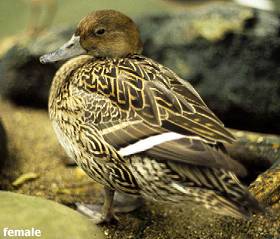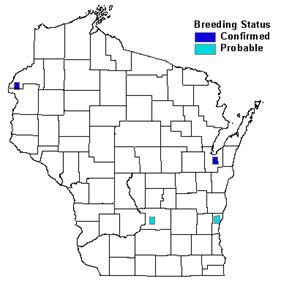

Status/Protection
- Global Rank: G5 Key to global and state ranks
- State Rank: S1B
- WBCI Priority: WFOWL, State Special Concern
Population Information
The Federal BBS information can be obtained at http://www.mbr-pwrc.usgs.gov/bbs/bbs.html by clicking on Trend Estimates and selecting the species in question. All estimates are for time period (1966-2005).
*Note: There are important deficiencies with these data. These results may be compromised by small sample size, low relative abundance on survey route, imprecise trends, and/or missing data. Caution should be used when evaluating this trend.
- Federal Breeding Bird Survey: significant decline
- Federal Breeding Bird Survey (WI): non-significant decline*
- Federal Breeding Bird Survey (BCR 23): non-significant decline*
- Federal Breeding Bird Survey (BCR 12): significant decline*
- Waterfowl Breeding Population and Habitat Survey: decline (1955-2006) (USFWS 2006)
- WSO Checklist Project: inverted u-shaped trend (1983-2007)
Life History
- Breeding Range: Alaska east across the Prairie Provinces of Canada south through the Great Basin and northern Great Plains states; local populations elsewhere in eastern Canada, U.S., (Austin and Miller 1995) eastern Siberia and Russia.
- Breeding Habitat: Northern Sedge Meadow and Marsh, Southern Sedge Meadow and Marsh, Emergent Marsh, Inland Open Water, Pasture, other grassland communities.
- Nest: Ground; scrape in residual cover of short grasses or other vegetation (Austin and Miller 1995); often far from water relative to other ducks.
- Nesting Dates: Eggs: Late April to early July.
- Foraging: Dabbles, ground glean (Ehrlich et al. 1988).
- Migrant Status: Short-distance migrant, Neotropical migrant.
- Habitat use during Migration: Row Crop, shallow wetlands, large lakes and reservoirs, estuarine and riverine wetlands.
- Arrival Dates: Early March to mid-May (Robbins 1991).
- Departure Dates: Late August to late November (Robbins 1991).
- Winter Range: Pacific and Atlantic coasts; southern U.S. to Central America.
- Winter Habitat: Flooded agricultural fields, reservoirs, tidal wetlands, shallow inland freshwater and intertidal habitats.
Habitat Selection
Although there are Wisconsin breeding records for Northern Pintail (Robbins 1991, Bacon 2006), the state is not within its core nesting area. This species characteristically nests in more open sites with less vegetative cover such as upland fields, along roadside allowances and fencerows, and in pastures (Stoudt 1971, Dwernychuk and Boag 1972, Higgins et al. 1992). It also frequently nests in fields used for agriculture (e.g., stubble, spring-seeded crops, hay) and nests established in such locations commonly are destroyed by farming operations (Podruzny et al. 2002). The Northern Pintail typically is associated with seasonal and semi-permanent wetlands that support a lush growth of emergent aquatic vegetation (Faanes 1981). Post-breeding males are commonly found on large, undisturbed shallow marshes with extensive emergent and submergent vegetation (Salomonsen 1968, Anderson and Sterling 1974). The interspersion of emergent vegetation with open water provides important food resources (Austin and Miller 1995). During spring and fall migration, Northern Pintails use shallow wetlands when not frozen, larger lakes and reservoirs, and various riverine wetlands (Austin and Miller 1995).
Habitat Availability
Wisconsin lies on the extreme southeastern fringe of the Northern Pintail’s breeding range (Robbins 1991) and is not part of its main migration route (Bacon 2006). Although potential breeding habitat exists on the Waterfowl Production Areas in southeast (4,000 hectares) and northwest (3,000 hectares) Wisconsin, the Northern Pintail is an uncommon breeder. However, intensive agriculture and urban development impacts the small breeding population by reducing upland habitats (WDNR 1995) and continued loss of wetlands will reduce available stopover habitat.
Population Concerns
Waterfowl Breeding Population and Habitat 2006 survey data indicate that Northern Pintails increased 32% relative to 2005, but remained 18% below their long-term average (USFWS 2006). Breeding Bird Survey data suggests a significant annual decline range-wide, but few data are available for Wisconsin (Sauer et al. 2005). Northern Pintails are a rare to uncommon summer resident throughout Wisconsin (Robbins 1991). In 2000-2004, an average of only 500 breeding pintails was estimated in Wisconsin (R. Gatti, WDNR, unpubl. data). During the Wisconsin Breeding Bird Atlas, observers confirmed breeding in only two locations within Burnett and Brown counties (Bacon 2006).
On the primary breeding grounds, continued drainage of wetlands, cultivation of preferred upland nest sites, and intense predation on nesting hens results in poor nest success and recruitment and impacts continental populations (Austin and Miller 1995). Changes in cropping practices, specifically change from summerfallow to continuous cropping, also may be an important factor in this species’ decline (Podruzny et al. 2002).
Recommended Management
Although the Northern Pintail is an uncommon breeder in the state, there is no indication that instituting targeted land management actions for this species will increase the breeding population. However, Northern Pintail will benefit from management efforts directed at other wetland-associated species. Efforts that protect existing wetlands and restore drained wetlands and conservation-oriented agricultural programs, such as the Wetland Reserve Program (WRP) and CRP, should be encouraged. U.S. harvest restrictions implemented since 1985 reduced Northern Pintail harvest to roughly 330,000 birds in 2002-2003 and to 1.8% of Wisconsin’s total duck harvest (Austin and Miller 1995, P. Padding, USFWS, unpubl. data). Annual changes in hunting regulations relative to changes in breeding population will continue to be adjusted to achieve appropriate harvest rates.
Research Needs
Habitats used during spring migration need to be identified and their role in acquisition of nutrient reserves for breeding needs to be addressed. Northern Pintail population size and productivity issues need to be assessed continentally in order to better understand the current population status of the species. Habitat management techniques need to be developed within core breeding range to enhance nesting effort, nest success, and recruitment. Additional research priorities include: (1) long-term nesting studies to measure factors controlling annual variation in production; (2) information on geographic variation in recruitment and survival rates; (3) information on the geographic relationship between nesting areas and ultimate wintering areas; (4) information on drought displacement and settling patterns relative to environmental conditions to better understand habitat-selection processes and productivity; and (5) information relative to nutrition, energy metabolism, and daily energy expenditure during winter and their effects on food consumption and reproduction (Austin and Miller 1995).
Information Sources
- Cornell Lab of Ornithology species account: http://www.birds.cornell.edu/AllAboutBirds/BirdGuide/Northern_Pintail.html
- North American Breeding Bird Survey: http://www.mbr-pwrc.usgs.gov/bbs/bbs.htm
- Temple, S.A., J.R. Cary, and R. Rolley. 1997. Wisconsin Birds: A Seasonal and Geographic Guide. Wisconsin Society of Ornithology and Wisconsin Department of Natural Resources, Madison, WI.
- Upper Mississippi River Great Lakes Joint Venture Implementation Plan: http://www.fws.gov/midwest/NAWMP/documents/WaterfowlManagementPlan.pdf
- Waterfowl Population Status report: http://www.fws.gov/migratorybirds/reports/status06/waterfowl%20status%202006.pdf
- Wisconsin Breeding Bird Atlas http://www.uwgb.edu/birds/wbba/
- Wisconsin Department of Natural Resources (WDNR). 1992. Upper Mississippi River and Great Lakes region joint venture – Wisconsin plan. Madison, WI.
References
- Anderson, D.R. and R.T. Sterling. 1974. Population dynamics of molting Pintail drakes banded in south-central Saskatchewan. J. Wildl. Manage. 38: 266-274.
- Austin, J.E. and M.R. Miller. 1995. Northern Pintail (Anas acuta). In The Birds of North America, No. 163 (A. Poole and F. Gill, eds.). The Academy of Natural Sciences, Philadelphia, and the American Ornithologists’ Union, Washington, D.C.
- Bacon, B. 2006. Northern Pintail. In The Wisconsin Breeding Bird Atlas (N.J. Cutright, B.R Harriman, R.W Howe, eds.) The University of Wisconsin Press: Madison, WI.
- Bellrose, F.C., F.L. Paveglio, Jr., and D.W. Steffeck. 1979. Waterfowl populations and the changing environment of the Illinois River Valley. Ill. Nat. Hist. Surv. Bull. 32: 1-54.
- Dwernychuk, L.W., and D.A. Boag. 1972. How vegetative cover protects duck nests from egg-eating birds. J. Wildl. Manage. 36: 955-958.
- Ehrlich, P.R., D.S. Dobkin, and D. Wheye. 1988. The birders handbook: a field guide to the natural history of North American birds. Simon & Schuster, Inc. New York.
- Faanes, Craig A. 1981. Birds of the St. Croix River Valley, Minnesota and Wisconsin. U.S. Department of the Interior. U.S. Fish and Wildlife Service, Washington, D.C. North American Fauna, Number 73. Northern Prairie Wildlife Research Center Home Page. http://www.npwrc.usgs.gov/resource/1998/stcroix/stcroix.htm (Version 31JUL98).
- Higgins, K.F., L.M. Kirsch, A.T. Klett, and H.W. Miller. 1992. Waterfowl production on the Woodworth Station in south-central North Dakota, 1965-1981. U.S. Fish and Wildl. Serv. Resour. Publ. 180.
- Keith, L.B. 1961. A study of waterfowl ecology on small impoundments in southeastern Alberta. Wildl. Monogr. 6.
- Podruzny, K.M., J.H. DeVries, L.M. Armstrong, J.J. Rotella, and J.H. Deviries. 2002. Long-term response of northern pintails to changes in wetlands and agriculture in the Canadian Prairie Pothole Region. Journal of Wildlife Management 66(4): 993-1010.
- Robbins, S.D., Jr. 1991. Wisconsin birdlife: Population and distribution past and present. Madison, WI: Univ. Wisconsin Press.
- Salomonsen, F. 1968. The moult migration. Wildfowl. 19: 5-24.
- Sowls, L.K. 1955. Prairie ducks. A study of their behavior, ecology, and management. Stackpole Co., Harrisburg, PA, and Wildl. Manage. Inst., Washington, D.C.
- Stoudt, J.H. 1971. Ecological factors affecting waterfowl production in the Saskatchewan parklands. U.S. Fish and Wildl. Serv. Resour. Publ. 99.
- United States Fish and Wildlife Service (USFWS). 2006. Waterfowl population status, 2006. U.S. Department of the Interior, Washington, D.C. U.S.A.
- Wisconsin Department of Natural Resources (WDNR). 1992. Upper Mississippi River and Great Lakes region joint venture- Wisconsin plan. Madison, WI.
- Wisconsin Department of Natural Resources (WDNR). 1995. Wisconsin’s Biodiversity as a Management Issue. http://dnr.wi.gov/org/land/er/biodiversity/report.htm
Contact Information
- Compiler: Steven C. Houdek, steve_houdek@usgs.gov
- Editor: Kim Kreitinger, K.Kreitinger@gmail.com
